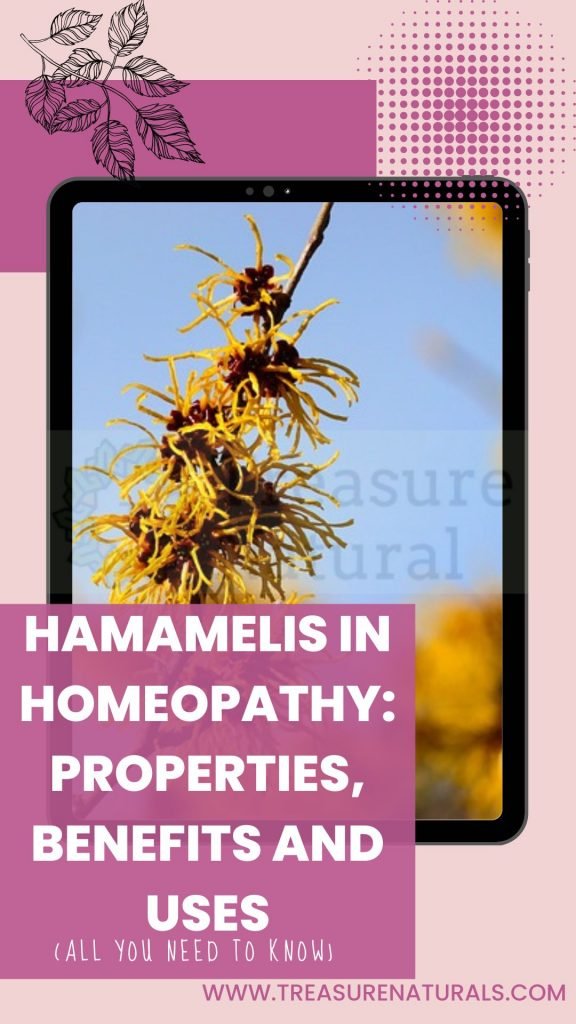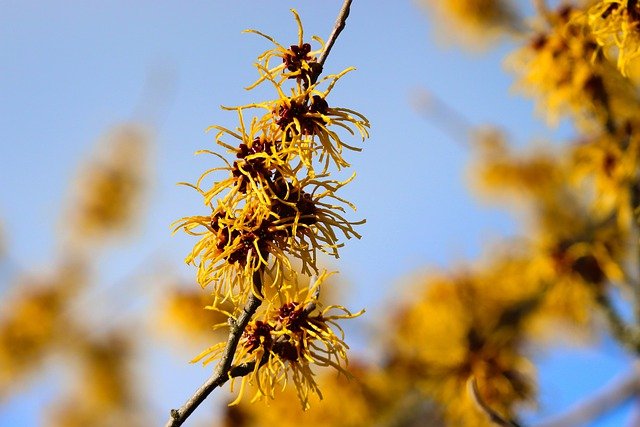
The homeopathic remedy Hamamelis is obtained from the fresh bark of the branches and the surface layer of the root of witch hazel, a plant native to North America that today also grows in Europe. The astringent hemostatic properties of its bark make Hamamelis an excellent remedy for hemorrhages, bruises and bruises.
witch hazel: history and benefits of the plant
Witch hazel is a shrub widespread in Europe and North America, belonging to the Hamamelidaceae family. This plant is also known by the name “witch-hazel” that is “witch’s core” as there are many benefits that once made it magical in the eyes of shamans.
It is in fact known since ancient times when the tribes of the American Indians, who knew very well the hemostatic and healing properties, used it to treat mouth and throat irritations, menstrual cramps, fever and colds, burns, insect bites and headaches. Subsequently, European settlers learned the secrets and virtues of this plant and applied it, exporting it to Europe as well.
In addition, this particular name is also attributed to the fact that the taste of its fruits is very reminiscent of hazelnuts and that with its trunk were made the handles of the brooms that legend tells are the means of transport of witches.
This plant, which looks like a shrub or small tree, usually grows in humid and bright woods and along the streams between the rocks. Its branches are rather sparse and the leaves large; flowering begins in autumn and continues in winter even after leaf fall. It has yellow flowers and fruits very similar to walnuts.
The active ingredients of witch hazel are contained in the bark of the youngest branches and its leaves. Witch hazel boasts a high percentage of tannins (3-10%), flavonoids (quercetin, myrtletine, astragaline, kaempferol), terpenes (saponins) and essential oil. Tannins, in particular, are mainly responsible for the astringent and hemostatic properties of the plant.
Usually the leaves are harvested during the summer (better June-July), while the bark is harvested in the spring, before the formation of shoots.
Today Witch Hazel is not only used in Homeopathy but also in herbal medicine and cosmetics, to prepare distilled waters, eye drops, decongestant tonics for children, soothing aftershave.
Hamamelis: Homeopathic remedy and properties
The witch hazel plant is a real panacea for the body because it helps to strengthen the venous and capillary walls, also eliminates the accumulation of fluid in the body. Witch hazel is one of the plants richest in tannins, substances with anti-inflammatory and antidiarrheal properties, which block bleeding, narrow blood vessels, strengthen the walls of veins and counteract stagnation of blood.
For all these reasons in 1850 Constantine Hering, one of the fathers of Homeopathy, experimented with excellent results. The homeopathic remedy Hamamelis, as already anticipated, is obtained from the fresh bark of the branches and the surface layer of the root of witch hazel. These parts of the plant are chopped, reduced to pulp and then subjected to the typical processes of Homeopathy.
The remedy is traditionally used in the following cases:
- very painful phlebitis processes with hemorrhagic diathesis;
- venous hemorrhages;
- lumbosacral pains, peritoneal and pelvic organ pains;
- venous stasis;
- pains from varicose veins, phlebitis;
- formation of varicose veins in pregnancy;
- pain and a sense of exhaustion;
- eye pain, hemorrhage of the vitreous body, venous atony;
- hemorrhoids;
- prolonged nosebleeds;
- bleeding inside the eye after trauma;
- disorders caused by ovulation or abundant menstrual flow;
- depression.
The homeopathic remedy hamamelis for Varicose veins
Varicose veins are a widespread problem, especially in women. These are permanent dilations of the venous walls that essentially affect the lower limbs (large or small saphenous and / or their tributaries). The appearance of varicose veins is mainly due to genetic factors that lead the walls of the veins to thin and to lose functionality to the valves and venous ducts that, in an upright position, facilitate the return of blood from the lower limbs to the heart (venous insufficiency).
Factors that usually affect the appearance of varicose veins are as follows:
- hereditary factors;
- sedentary lifestyle;
- improper feeding;
- hormonal problems;
- obesity;
- smoke.
The homeopathic remedy Hamamelis is particularly indicated in case of varicose veins as it has a venotonic action that favors the contraction of blood vessels, capillaries and veins, thus improving blood flow. In addition, vitamin P, contained in the plant, reduces inflammation and edema by deflating veins and capillaries.
Hamamelis: constitutional type

The Hamamelis type often has blond hair and is a subject who has difficulty making decisions on his own, a task that he tries to delegate to others.
He is generally very insecure and therefore trusts his neighbor who, however, sometimes disappoints him.
He often wants to be left alone, wants others to show him respect, and feels irritable and restless (depressive state).
Below are the main characteristics of the remedy in reference to the subject for whom it is particularly indicated:
General action:
- venous system.
Generality:
- feeling of contusion in the affected areas;
- bruising from capillary fragility;
- aggravation with trauma.
Main clinical indications:
- varicose veins of the lower extremities;
- hemorrhoids;
- subconjunctival hemorrhages;
- post-traumatic hemorrhages of dark blood.
Usually the symptoms presented by the subject Hamamelis improve with fresh air, reading, thinking or talking; they worsen with heat and moist air, with pressure and movement.






